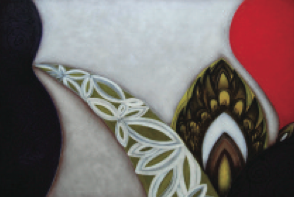Mario Bencomo
The Americas Collection, Miami
Opalia is the title of the most recent exhibition of works by the Cuban-American artist Mario Bencomo, presented by The Americas Collection. As is customary with Bencomo’s work, this show constitutes a key, a door, the passage leading to a world of fantasy interwoven with myth and psychoanalysis.

The exhibition’s title, Opalia, is derived from the name of the popular Roman festival of the Classical Era held in honor of Ops or Opis, the goddess of abundance. Associated with two other essential deities, the granary god Consus, and Saturn, the embodiment of Time, Opalia thus incar- nates the celebration of harvest time and good weather, the song to reproduction, abundance and life.
Assuming this idea as emblematic of his work, we find two vital signs that, like hidden keys or talismans, proliferate in a magnificent copula in this series. I am referring to the almond and the horn. The first of these contains, in its feminine nature, the capacity to receive and give life; the second is a symbol of virility, sharp and hurtful, while simultane- ously a complement and echo of the first − an analogy derived from its own morphology of Cornu Copiae or horn of plenty. The almond shape is always well received because its graceful configuration underlies almost all natural forms. Eyes, vulvas, petals, leaves. And it also makes reference to the ‘mandorla’ − the Italian word for almond., the symbol of mediaeval Christianity that results from the superposition of two circles drawing near to one another, outlining an almond at the inter- section, and that implies the relationship and interdependence of opposing and conflicting forces. And it is precisely in this space that Mario Bencomo’s current series develops.
Alongside these two recurring elements, which acquire the sta- tus of personages and coexist in a dialogic relationship within the painting, we find the checkerboard structure which, whether intentionally or randomly, constitutes the framework for the central motifs. Particularly noteworthy in this respect is Godess Maze I. In this work, the checkerboard structure is displayed on the plane to host two oval shapes containing the myth. Occasionally, small corporeal details endowed with multiple meanings appear in the manner of decoys.
The logic of the Ecstasy is one of the best-achieved works in the series. In it, time appears to have stood still. The plane is subdivided into horizontal strips reminiscent of trails which contribute balance, and on which unknown legends that are keys to our future are displayed. A master of acrylic, Mario Bencomo produces his works under a veil, shutting out the light. The tiresome process of creation implies working in layers, a sort of archaeology of the soul thanks to which the artist gradually obtains light from the shadows. Another essential aesthetic component that delights the viewer when approaching the work is the careful elaboration of the texture that, like a filigree, is interwoven throughout the canvas. “It is,” Bencomo explains, “the same feeling of discovery created by the superposition of two veils through which you try to decipher the face, to find out the soul.”
Opalia is a magnificent feast.





